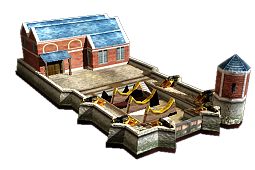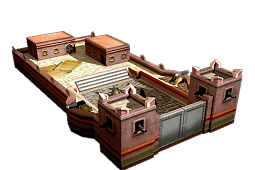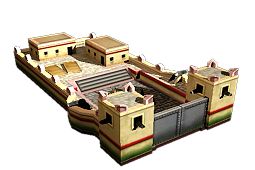Drydock (ETW building)
| Drydock | |||||||
|---|---|---|---|---|---|---|---|
| Category: | Port - Navy | ||||||
| Level: | 2 | ||||||
| Turns to build: | 4 | ||||||
| Building cost: | 3500 | ||||||
| |||||||
| Requires | |||||||
| Dockyard | |||||||
| Technology | |||||||
| Naval Architecture Advances | |||||||
| Enables | |||||||
| Naval Hospital | |||||||
| Steam Drydock | |||||||
A dry dock is a large brick or stone basin with a set of watertight gates. Once a ship has floated in, the lock gates are shut and the dock drained.
Within the dry dock, the ship is supported on blocks, and extra timbers are used to wedge firmly upright as the water is removed. By carefully timing the movement of a ship to take advantage of high and low tides, the amount of pumping (by hand) is minimised. Movements into and out of the dock are tidal, and work must be finished by the next high tide.
The advantages of being able to work on a warship and then float it away are considerable. Dry docks are equally useful for construction and repair, and are often at the centre of a large complex of workshops specialising in every aspect of shipbuilding.
The organisation required for all this activity means that the craft-based skills of the master shipwright are still valuable, but naval architects producing plans, drawings and schedules are now a vital part of the process. Naturally, the master of the docks can treat the entire enterprise as his own (as long as he delivers the ships needed) and award contracts as he sees fit to his friends and cronies! Officials making profits from the government’s investment was an accepted cost of business and, provided the men were not too greedy, an assurance that they were looking after their interests and those of the navy!





